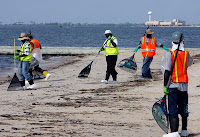
When disaster strikes, it happens suddenly. It doesn’t call and come or inform us before. So what do we really do when a big disaster like the Gulf of Mexico oil spill strikes again? We better be prepared.
The topic on Oil Clean up Safety materials have been a much debated one since the BP disaster took place. This blog will provide a basic overview of the oil clean up safety.
Let’s keep in mind that the BP oil disaster wasn’t an ordinary one but a huge disaster call. The clean up effort has also been massive and with the support of a large number of clean up personnel and volunteers, it has been very successful. The workers have to deal with the dangers of the exposure to crude oil, dispersant's, chemical additives and cleaning chemicals. Not only that but also face job site hazards such as falls, drowning, sharp objects, wildlife and heat.
OSHA has been carefully scrutinizing the whole episode of the disaster and some of the facts that they have provided are:
After the oil spill, a great number of people or workers required the HAZWOPER training as more workers were required for the clean up effort and without training no one could join it as well.
So, its better to be prepared with the training, rather than wait for the disaster to happen and start with the training.
The topic on Oil Clean up Safety materials have been a much debated one since the BP disaster took place. This blog will provide a basic overview of the oil clean up safety.
Let’s keep in mind that the BP oil disaster wasn’t an ordinary one but a huge disaster call. The clean up effort has also been massive and with the support of a large number of clean up personnel and volunteers, it has been very successful. The workers have to deal with the dangers of the exposure to crude oil, dispersant's, chemical additives and cleaning chemicals. Not only that but also face job site hazards such as falls, drowning, sharp objects, wildlife and heat.
OSHA has been carefully scrutinizing the whole episode of the disaster and some of the facts that they have provided are:
- The agency has more than 2,000 federal employees supervising the whole effort of the 25,000 clean up workers and 5,000 plus boats.
- The agency is working with the National Institute of Environmental Health Sciences (NIEHS) and National Institute for Occupational Safety and Health (NIOSH) to ensure that appropriate HAZWOPER safety training is provided to workers hired by BP.
- OSHA has over 146 professionals allotted every day to protect workers throughout the Gulf Region and out of which 25 of them are solely assigned to the Oil Response Clean up.
After the oil spill, a great number of people or workers required the HAZWOPER training as more workers were required for the clean up effort and without training no one could join it as well.
So, its better to be prepared with the training, rather than wait for the disaster to happen and start with the training.
Comments
Post a Comment